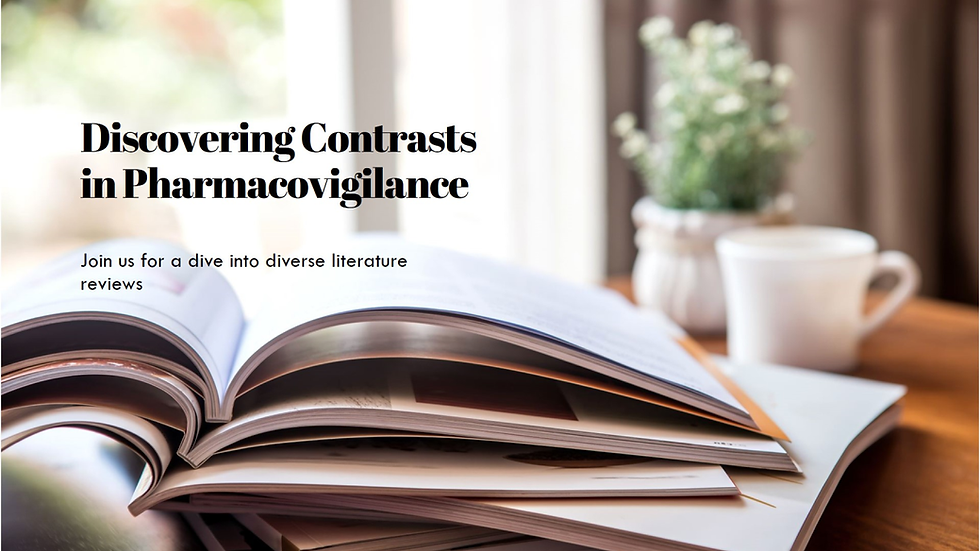
In the expansive realm of pharmacovigilance, where the safety of medications is of paramount importance, literature reviews serve as a cornerstone for identifying and assessing adverse drug reactions (ADRs). However, within the vast landscape of biomedical literature, there exist diverse approaches and methodologies for conducting literature reviews, each with its own strengths and limitations. This blog delves into the contrasts and nuances inherent in pharmacovigilance literature reviews, shedding light on the various methodologies, challenges, and opportunities for advancing safety surveillance and evidence synthesis.
The Significance of Literature Reviews in Pharmacovigilance:
Literature reviews play a critical role in evidence-based pharmacovigilance by providing a comprehensive overview of existing research findings, clinical trials, case reports, and regulatory documents related to the safety of medications. These reviews serve as the foundation for identifying potential safety signals, evaluating the strength of evidence, and informing regulatory decisions and risk management strategies.
Pharmacovigilance literature reviews inform decision-making processes at all stages of the drug development and post-marketing lifecycle. By synthesizing evidence from diverse sources, researchers and regulatory agencies can assess the safety profile of medications, identify emerging risks, and make informed recommendations regarding drug use, labeling, and surveillance activities.
Contrasts in Literature Review Methodologies:
Systematic reviews adhere to a rigorous methodology involving predefined search strategies, inclusion criteria, and data extraction protocols. These reviews aim to minimize bias and maximize transparency by systematically identifying, appraising, and synthesizing relevant evidence. In contrast, narrative reviews provide a qualitative summary of literature without strict adherence to predefined methods, offering a more flexible and interpretive approach.
Quantitative literature reviews employ statistical methods to analyze and synthesize numerical data, such as effect sizes, risk ratios, and confidence intervals. These reviews provide quantitative estimates of treatment effects and adverse outcomes, facilitating meta-analyses and evidence-based decision-making. Conversely, qualitative reviews focus on synthesizing descriptive data, themes, and patterns from qualitative studies, offering insights into patient experiences, perceptions, and treatment preferences.
Challenges and Considerations:
The diverse nature of pharmacovigilance literature presents challenges in terms of data heterogeneity, variability in study designs, and inconsistencies in reporting standards. Integrating data from disparate sources, such as clinical trials, observational studies, and spontaneous reporting systems, requires careful consideration of methodological differences and potential biases.
Bias and confounding factors inherent in observational studies and retrospective analyses can influence the interpretation of safety data and findings from literature reviews. Common sources of bias include selection bias, recall bias, and publication bias, which may skew the results and conclusions of pharmacovigilance literature reviews. Rigorous appraisal and sensitivity analyses are essential for addressing bias and ensuring the validity of review findings.
Opportunities for Advancement:
Advancements in real-world data sources, such as electronic health records, claims databases, and social media platforms, present opportunities to enhance pharmacovigilance literature reviews. By integrating real-world data into systematic reviews and meta-analyses, researchers can complement findings from traditional sources and gain insights into medication use, safety outcomes, and patient perspectives in real-world settings.
The integration of artificial intelligence (AI) and machine learning technologies offers potential solutions for streamlining literature review processes and enhancing data analysis in pharmacovigilance. AI-driven algorithms can automate data extraction, identify relevant studies, and detect emerging safety signals with unprecedented speed and accuracy, revolutionizing evidence synthesis and safety surveillance.
Conclusion:
Pharmacovigilance literature reviews represent a diverse and multifaceted landscape, characterized by contrasting methodologies, challenges, and opportunities. By embracing the nuances of different review approaches and methodologies, researchers and regulatory agencies can enhance safety surveillance, inform evidence-based decision-making, and ultimately improve patient outcomes. As the field continues to evolve, collaboration, innovation, and methodological rigor will be essential for advancing pharmacovigilance literature reviews and ensuring the safe and effective use of medications worldwide.

Comments